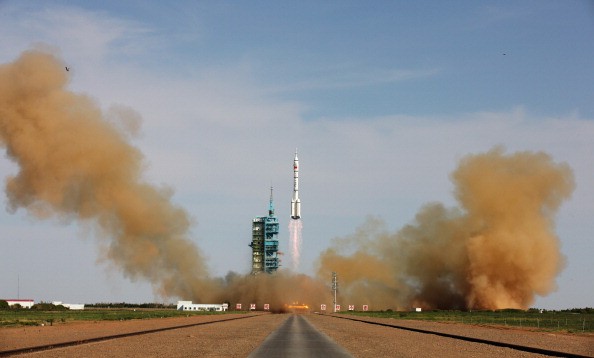Embryos Develop in Outer Space, China's SJ-10 Has Some Proof
| Jenia Cane | | Apr 18, 2016 09:58 PM EDT |
(Photo : ChinaFotoPress/Getty Images) The Long March-2F rocket carrying China's manned Shenzhou-10 spacecraft blasts off from launch pad at Jiuquan Satellite Launch Center on June 11, 2013 in Jiuquan, Gansu Province of China. China's latest manned spacecraft blasted off on a 15-day mission to dock with a space lab.
China's SJ-10 recoverable satellite revealed that a mammal embryo can develop in outer space, however, it still needs ample time before the human race can actually "colonize" it.
On April 6, China launched the microgravity satellite wherein its return capsule is set to stay in the orbit for a number of days before it goes back to Earth.
Like Us on Facebook
According to China Daily, a professor at the Institute of Zoology affiliated with the Chinese Academy of Sciences pointed out that it surely takes a while before it can be proven that the outer space can be considered a home for humans.
"The human race may still have a long way to go before we can colonize space but, before that, we have to figure out whether it is possible for us to survive and reproduce in outer space like we do on Earth," Duan Enkui, who is also the principal researcher of the study, said.
"Now, we have finally proven that the most crucial step in our reproduction-early embryo development-is possible in outer space," he added.
Meanwhile, Duan explained that "Since space experiments are expensive, no one attempted to develop embryos again in the decade following NASA's failure."
It can be recalled that in 2006, NASA's STS-80 Spacecraft attempted to develop mammalian embryos in space. But, all 49 mouse embryos were successfully developed.
Ten years after, China launched SJ-8, a recoverable satellite, which had four embryos in it. While it was successful in sending high-resolution images of the embryos, it was unfortunate that none of them ever grew.
With the newest satellite which China sent to the outer space earlier this month, it was noted that of the more than 6,000 mouse embryos were on-board the SJ-10, some of them developed into advanced blastocysts in four days' time, something which can be considered as a milestone.
©2015 Chinatopix All rights reserved. Do not reproduce without permission
EDITOR'S PICKS
-

Did the Trump administration just announce plans for a trade war with ‘hostile’ China and Russia?
-

US Senate passes Taiwan travel bill slammed by China
-

As Yan Sihong’s family grieves, here are other Chinese students who went missing abroad. Some have never been found
-

Beijing blasts Western critics who ‘smear China’ with the term sharp power
-

China Envoy Seeks to Defuse Tensions With U.S. as a Trade War Brews
-

Singapore's Deputy PM Provides Bitcoin Vote of Confidence Amid China's Blanket Bans
-

China warns investors over risks in overseas virtual currency trading
-

Chinese government most trustworthy: survey
-

Kashima Antlers On Course For Back-To-Back Titles
MOST POPULAR
LATEST NEWS
Zhou Yongkang: China's Former Security Chief Sentenced to Life in Prison

China's former Chief of the Ministry of Public Security, Zhou Yongkang, has been given a life sentence after he was found guilty of abusing his office, bribery and deliberately ... Full Article
TRENDING STORY

China Pork Prices Expected to Stabilize As The Supplies Recover

Elephone P9000 Smartphone is now on Sale on Amazon India

There's a Big Chance Cliffhangers Won't Still Be Resolved When Grey's Anatomy Season 13 Returns

Supreme Court Ruled on Samsung vs Apple Dispute for Patent Infringement

Microsoft Surface Pro 5 Rumors and Release Date: What is the Latest?











